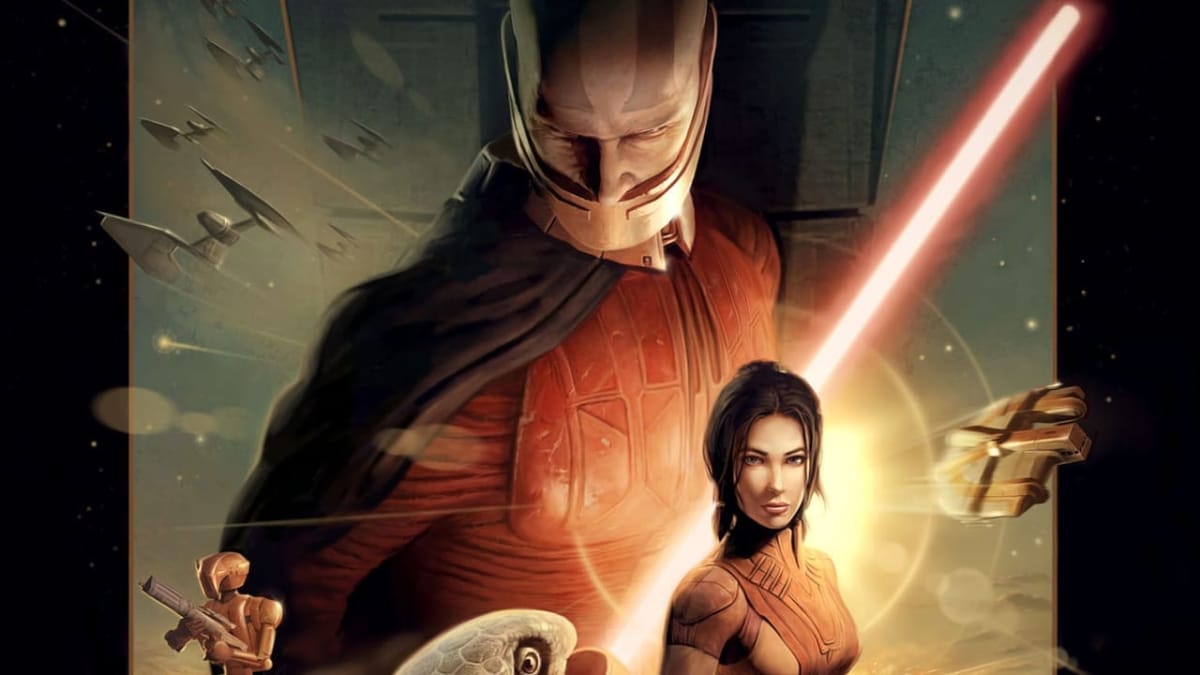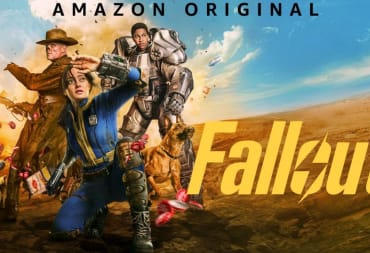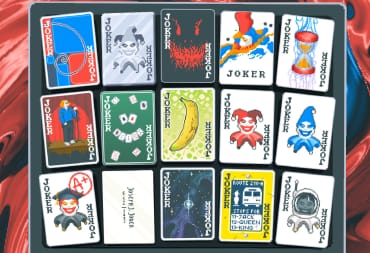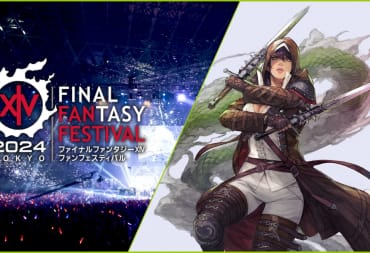Star Wars has always been a marquee property in media. The popularity of the movies to the widespread love for the formerly-extended universe have not waned for over forty years. Like any multi-media franchise, some adaptations stand out more than others, nostalgic memories overflowing us in our rosy-colored glasses that define our expectations.
The movies were always the primary focus for original fans. For those who grew up in the shadow of Star Wars, however, it sometimes comes from the unlikeliest of places, like a video game. Many games have been made for Star Wars before, but very few take a gamble to allow the player to play in the sandbox of the Galaxy Far, Far Away. For many, that nostalgic memory is strongest with one of arguably the best Star Wars games ever made, the classic RPG Star Wars: Knights of the Old Republic.
Now celebrating its 15-year anniversary, Knights of the Old Republic was unique as it was one of the few points in the Star Wars fandom to not focus on the current or future events of the films. It instead looked back to the far past—over 4,000 years in fact—to an age where the Empire never existed. LucasArts at the time was expanding, thanks in part to the success of 1999’s The Phantom Menace, and was looking to increase production on Star Wars media into new territories with video games.
Enter BioWare, who at the time in 1999 was in early talks with LucasArts for delivering a game. In 1999, BioWare was a rising star on the PC market after the success of Baldur’s Gate. The faithful adaptation of Advanced Dungeons and Dragons Rules, along with their team working on two concurrent projects—Baldur’s Gate II and Neverwinter Nights—gave them enough clout to correspond with LucasArts, who asked the company to help co-develop an RPG.
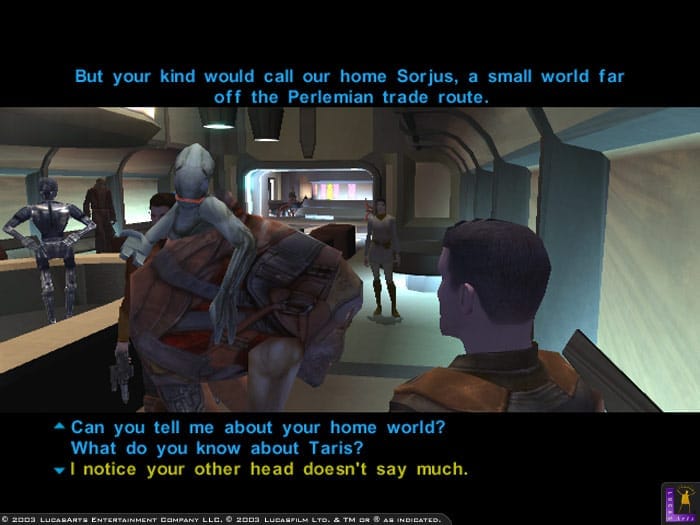
Famously, LucasArts gave BioWare a choice between setting it during Episode II: Attack of the Clones or in the far past of the Star Wars universe. The team chose the far past, primarily because it allowed for more creative freedom to develop the game with a custom cast of characters. BioWare was also given little restrictions in terms of the game design, with former CEO Ray Muzyka noting that almost all concept art sent to the Skywalker Ranch for approval was accepted, with minor alterations.
At the time of its release in 2003, few properties delved deeply into Star Wars lore. One of the few examples at the time was the Tales of the Jedi comic series by Dark Horse, which covered the Great Sith War among other events in the early timeline. Knights of the Old Republic would add onto this thread, taking place just after the Great Sith War, expanding on the rise of the Sith fleet against the galaxy. The continuity with Tales of the Jedi would have seen a character from the comics, Vima Sunrider, make an appearance as a main character in the game. However, issues with the Sunrider name forced her out of the game, replacing her character with Bastila Shan.
The game's production officially began in 2000, as development was wrapped up on Baldur’s Gate II. The team at the time was working on a new gameplay engine, titled the Aurora Engine, which was used primarily for the development of Neverwinter Nights. LucasArts was impressed by the graphical engine and pushed for BioWare to incorporate the high 3D style into Knights of the Old Republic.
This proved to be one of the game's biggest challenges during development. The game's director, Casey Hudson, noted that the level of graphical detail was not up to par with the large set pieces planned for the game. Giant hub worlds, such as Taris, were infinitely more complex than anything the team had developed before. Hudson also pushed for a more cinematic style for Knights of the Old Republic to closely match the movies, including the use of widescreen and sprawling vistas, frame wipes, and other camera tricks to help enhance the viewing experience of the game.
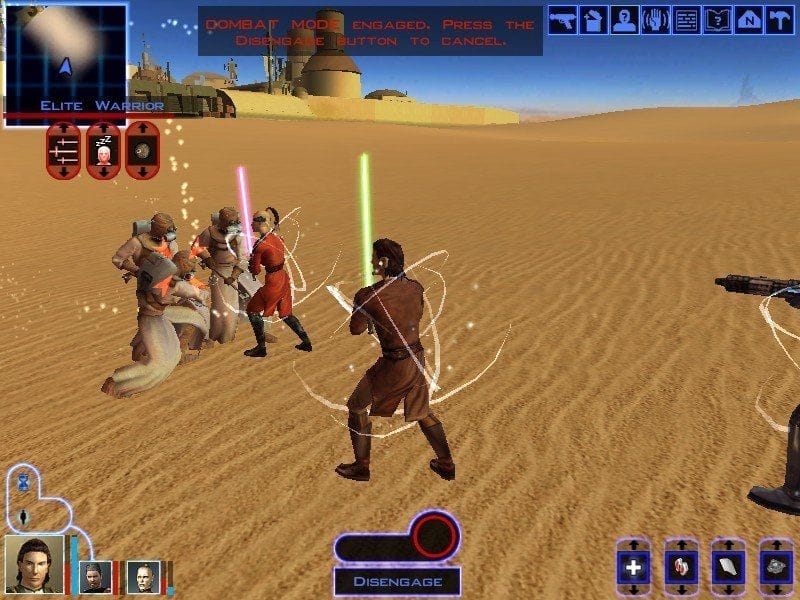
The Aurora engine also had to accommodate this cinematic style with the combat mechanics. Knights of the Old Republic was based on an OGL version of the 3rd Edition Dungeon and Dragons game system, which was first released in the Star Wars universe in 2000 by writers Andy Collins, JD Wiker, and Bill Slavicsek. Knights of the Old Republic would be one of the first third-party properties to feature a d20 system in video game form, incorporating numerous feats, talents, skills, and more to fully customize a character into one of six classes.
For BioWare, much of the overall development process for Knights of the Old Republic was to modify the Aurora Engine to allow for a more cinematic experience. By the time Neverwinter Nights was released in 2002, BioWare had already transitioned to the Odyssey Engine, a heavily modified version of Aurora, for these changes. The Odyssey Engine, at the time, accounted for a high level of graphical detail on character models, along with smaller touches, such as swaying grass in the wind or footsteps kicking up sand on a beach.
BioWare also had to contend with one final obstacle: bringing the game to the Xbox. BioWare had experience with console releases before, but LucasArts early on wished to release Knights of the Old Republic onto the original Xbox along with the PC without many alterations. At the time, LucasArts believed the original Xbox would be powerful enough to fit such a massive game on the system. Ultimately, some limitations for the Xbox version still needed to be made. Major changes included limiting the number of NPCs on screen and a whole area of the game was exclusive to the PC version. Otherwise, the game was a faithful version of the PC title.
Between all this though, the biggest contribution Knights of the Old Republic had would be the use of moral choice. As a gameplay mechanic, it was designed partially to have a physical alignment system incorporated into the game, harking back to the tabletop roots of the game's ruleset. This allowed certain powers and abilities to be unlocked exclusively to one’s alignment, regardless of their class, further customizing the experience for the player.
Alignment also tied into the game's narrative, which was critically acclaimed at the time of release. This is partially due to the massive twist towards the end of the game regarding the relationship between the two primary Sith, Revan and Malak. It is not an understatement when much of the game's reception and success was from this twist. So much so, that LucasArts quickly commissioned a sequel, with BioWare suggesting Obsidian Entertainment helm the sequel due to the strict mandate of a year’s development time.
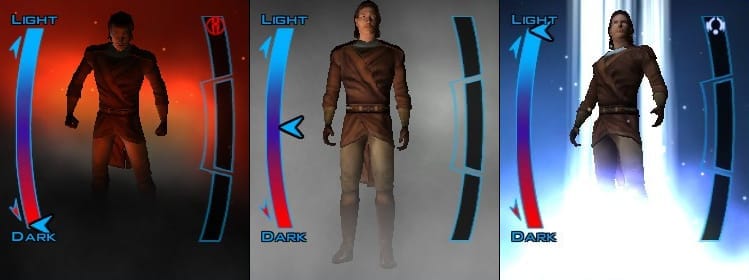
For BioWare, Knights of the Old Republic would go on to sell an estimated 3.7 million units by 2007, making it BioWare’s most successful title at the time. Despite this, BioWare still struggled as an independent developer. The overall development costs, tied with LucasArts marketing for the game, ballooned to a high amount in 2003. Official numbers are unknown, but by 2005, the multiple projects the team was working on would begin to bleed the company, until the intervention of Microsoft Game Studios who pledged to publish their next title, their first original I.P Jade Empire, in 2005. Eventually, Microsoft would give the company support for what would arguably be BioWare’s biggest franchise to date; the first Mass Effect in 2007.
The legacy of Knights of the Old Republic, however, lives on. Not only was it influential in delivering a cinematic style to Star Wars games, but it was able to do so without the star power of recognizable characters, proving that there is a market for more expanded lore in the Star Wars universe. Many of its mechanics would be utilized in future role-playing games throughout the early 2000s. Of particular note is the incorporation of a binary morality system in most RPGs to this day. The game's cinematic style would be improved on by BioWare over the years, becoming one of the hallmarks of their own design philosophy. It would also be the last BioWare game to be fully engrossed in a rule set based on a tabletop setting.
BioWare would eventually go back to Star Wars with the now-successful MMORPG, Star Wars: The Old Republic, a game that would cost nearly $200 million to develop. The Old Republic is also the last active part of the Star Wars expanded universe after the acquisition of the Star Wars brand by Disney erased the expanded universe to implement their own canon.
The legacy of Knights of the Old Republic is one of taking a chance and expanding beyond what is expected by the fanbase. Fifteen years on, the game still provides the same excitement and aesthetics you would expect from a Star Wars property, and being an RPG, allows players to fully participate in the sandbox more actively than other parts of the franchise. Most importantly, it showed that big-budget RPGs for the PC can also be made for consoles, something unheard of in the early 2000s.
While time has weathered it for sure, Knights of the Old Republic is often cited as one of the most important RPGs of all time due to its innovations and marrying of role-playing mechanics to a cinematic style. It was the game that put BioWare on the map and to this day has fans asking for more games and stories in the Old Republic period. It is a heritage that will never be forgotten.
It's been a long time since I did a Playing Roles article. I figure if we're going to revisit this series, might as well start by doing a short retrospective on one of the most popular RPGs of all time.
This post was originally published in 2018 as a part of our Playing Roles series. It's been republished to have better formatting.
Have a tip, or want to point out something we missed? Leave a Comment or e-mail us at tips@techraptor.net
